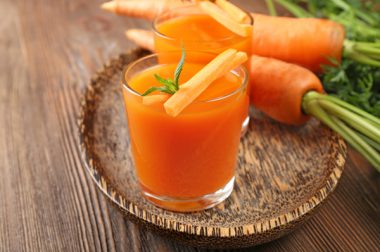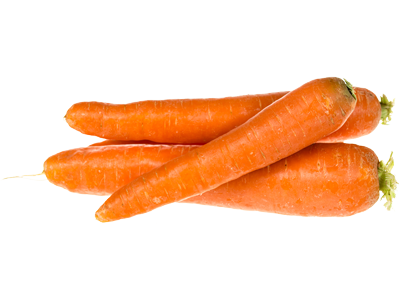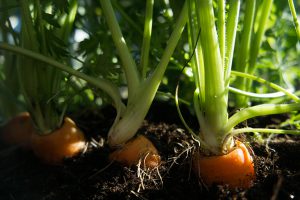Health
benefits
For peachy skin and lynx vision
Due to its richness in beta-carotene or pro-vitamin A, carrots maintain healthy skin and eyes by contributing to good night vision.
The ABCs of Beta-Carotene
- he more colorful the carrots, the more carotenoids they contain. Brown carrots are said to contain twice as much beta-carotene as orange carrots, while yellow carrots contain very little and white carrots none at all.
- Carotenoids are best absorbed with fat, as they are fat-soluble. The oil from the vinaigrette in grated carrots is therefore welcome! This also applies to all other carotenoids in carrots, such as lutein and zeaxanthin.
Carrot also contains:
- soft fibers
- vitamin B6
- potassium
- magnesium
- phosphorus
Remember: the highest quantities of carotenoids are found in frozen carrots (ahead of cooked carrots, then raw carrots which contain 3 times less than frozen ones)!
Nutritional
composition
When is the right
time to eat them?
All year round.
Carrots are available all year round, but their peak season runs from August to March! However, for early carrots, tasting is concentrated from May to July.
Vegetable patch or
urban balcony?
A biennial plant, carrots are very easy to grow and thrive in sandy, well-drained, neutral and light soils, as well as sunny and partially shaded exposure.
Choosing and
storing
To choose your carrot well:
- Watch their color which must be intense. The tops (their leaves) must also be very green and… not wilted.
- Several varieties allow you to find them all year round on the stalls: the early ones, then the precocious ones, the “firsts”, the “new ones”, then the “conservations”…
To properly store your carrot:
- Carrots keep well away from light and humidity.
- To preserve them better: cut the tops before storing them in the vegetable drawer of the refrigerator for 3 to 4 days.
- So-called “keeping” carrots can be stored for up to 8 days. But if you have a very cool, well-ventilated place with controlled humidity in your home, you can keep them for much longer.
Tips and
tricks
The carrot is prepared…
Carrots can be cut in any size, shape or cooking method; they are a real pleasure to cook! They can be cut into julienne strips or cubes; they can be sliced, grated or crunched.
Some guidelines for cooking times:
- Pressure cooker: 8 to 10 minutes
- Braised or stewed: between 20 and 30 minutes
- In water: count 30 minutes
- In the microwave: 10 minutes, preferably cut into slices
- On the barbecue: and yes, it’s possible too. With a good marinade, count 45 minutes
Carrot goes well with…
Carrots go well with almost everything, in sweet or savory versions, in the form of cakes, pies, soups, veloutés, cakes, vegetable terrines, salads, dips, sauces, etc.
Herbs (thyme, parsley), spices, fresh or dried fruits (oranges, lemon, fresh or dried grapes, etc.), nuts and seeds (walnuts, almonds, pine nuts, pumpkin seeds, etc.), condiments (garlic, shallots, onions, olives, etc.), other summer or winter vegetables (peppers, celery, potatoes, beetroot, etc.), meats and fish: everything suits them!
Tip to better assimilate the carotenoids in carrots. Prepare them with a little fat: oil, butter, nuts or cheese. Carotenoids are fat-soluble compounds, so they are soluble in fat!
Can everyone
eat them?
Toddlers
Carrots can be offered as a puree from the start of solid food. Its sweet flavor generally makes it very popular with babies.

In many countries, carrots are one of the most commonly offered vegetables to children, starting from a very young age. Early introduction and regular exposure are two keys to ensuring their appreciation throughout life.
And the others…
For older people, however, cooked forms will be preferred because they are easier to eat!
Where do they come from?
Origins and varieties
Origins
Global production is concentrated in China, the United States and Russia, mainly in the Northern Hemisphere. In Europe, the podium is occupied by Poland, the United Kingdom and the Netherlands.
Varieties
From yellow to purple, from miniature to larger carrots, there are several different varieties of carrots on the shelves. Their sweet taste varies depending on the cultivar.



 Carott
Carott  Rosemary or Rosmarinus officinalis
Rosemary or Rosmarinus officinalis  Vegetable garden: growing soy bean
Vegetable garden: growing soy bean 










